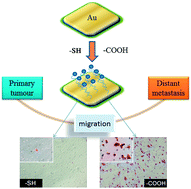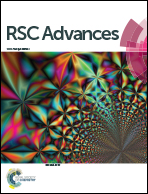Effects of different functional groups on metastatic behavior of SPC-A-1/human lung cancer cells in self-assembled monolayers†
Abstract
Cancer cell processes and tumor microenvironment play key roles in metastasis, which is the primary cause of death from lung cancer. We utilized self-assembled monolayers terminated with different functional groups (–CH3, –OH, –COOH, –NH2, –SH) to explore their effects on the metastatic behavior of human lung cancer cells (SPC-A-1) in vitro. Cell adhesion was investigated by scanning electron microscopy and 4,6-diamidino-2-phenylindole staining; rhodamine–phalloidin was further used to directly label microfilaments. Viability/cytotoxicity staining and lactate dehydrogenase assays were performed to determine cell toxicity, and apoptosis was investigated by flow cytometry. Transwell assays were used to analyze the relationship between cell migration and surface chemistry. Gene expression associated with metastatic behavior was measured by quantitative real-time PCR. Our results demonstrated that –NH2 and –COOH groups promote cell adhesion and spreading. Although the –OH group did not affect cell survival and mobility, –CH3 and –SH groups were toxic to SPC-A-1 cells after 24 h of incubation. Furthermore, the –SH group inhibited cell migration and increased gene expression of E-cadherin. The addition of the –SH group has a potential application in new biomaterials or drugs for lung cancer metastasis therapy.


 Please wait while we load your content...
Please wait while we load your content...